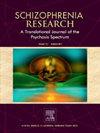情感性和非情感性早期精神病的胼胝体微观结构改变:一项扩散磁共振成像研究
IF 3.5
2区 医学
Q1 PSYCHIATRY
引用次数: 0
摘要
背景:重度精神病(EP)与多种脑区,特别是胼胝体(CC)的白质微观结构完整性破坏有关。本研究利用EP患者弥散加权磁共振成像数据,采用弥散张量成像(DTI)、游离水校正弥散成像(free watercorrected diffusion)、神经突定向弥散密度成像(NODDI)等方法对脑白质微观结构进行综合评价。方法从早期精神病数据集中的人类连接组项目中纳入106例EP患者(84例非情感性和22例情感性)和51例健康对照(hc)。我们对CC的三个部分进行了导管特异性分析,并对每个部分的扩散测量进行了量化。通过多变量协方差分析评估EP与hc以及情感性与非情感性精神病之间的CC测量差异。采用主成分分析法对扩散指标进行降维。结果sep与CC体内白质完整性的破坏有关,这可以通过较低的各向异性分数和细胞内体积分数以及增加的弥散性指标来表明。在CC亚区中,EP组和HC组之间、情感组和非情感组之间,CC的膝和脾无显著差异。此外,较低的膝白质完整性与症状严重程度的增加略有相关。结论脑电图的病理生理机制可能与穿越CC的白质纤维微结构改变有关。这些发现可能有助于提供越来越多的证据,表明白质破坏是疾病易感性的潜在生物标志物。本文章由计算机程序翻译,如有差异,请以英文原文为准。
Microstructural alterations of the corpus callosum in affective and non-affective early psychosis: A diffusion magnetic resonance imaging study
Background
Early psychosis (EP) is associated with a disrupted integrity of the white matter microstructure of a variety of brain regions, especially the corpus callosum (CC). In this study, we used diffusion-weighted magnetic resonance imaging data of patients with EP and employed diffusion tensor imaging (DTI), free water-corrected diffusion, and neurite orientation dispersion and density imaging (NODDI) to comprehensively assess the white matter microstructure.
Methods
106 patients with EP (84 non-affective and 22 affective) and 51 healthy controls (HCs) were included from the Human Connectome Project in the Early Psychosis dataset. We used tract-specific analysis for tractography of three parts of the CC and quantified the diffusion measurements for each segment. CC measurement differences between EP vs. HCs and affective vs. non-affective psychosis were assessed by multivariate analysis of covariance. Principal component analysis was used for dimension reduction of diffusion metrics.
Results
EP was associated with disrupted white matter integrity in the body of CC indicated by a lower fractional anisotropy and intracellular volume fraction, alongside increased diffusivity measures. None of the CC subregions showed a significant difference in the genu and splenium of the CC between EP and HC groups or between affective and non-affective subgroups. Furthermore, lower white matter integrity in the genu was marginally associated with increased symptom severity.
Conclusions
Our findings suggest that microstructural alterations of white matter fibers crossing CC may underlie the pathophysiology of EP. These findings may contribute to a growing body of evidence pointing to white matter disruption as a potential biomarker of disease vulnerability.
求助全文
通过发布文献求助,成功后即可免费获取论文全文。
去求助
来源期刊

Schizophrenia Research
医学-精神病学
CiteScore
7.50
自引率
8.90%
发文量
429
审稿时长
10.2 weeks
期刊介绍:
As official journal of the Schizophrenia International Research Society (SIRS) Schizophrenia Research is THE journal of choice for international researchers and clinicians to share their work with the global schizophrenia research community. More than 6000 institutes have online or print (or both) access to this journal - the largest specialist journal in the field, with the largest readership!
Schizophrenia Research''s time to first decision is as fast as 6 weeks and its publishing speed is as fast as 4 weeks until online publication (corrected proof/Article in Press) after acceptance and 14 weeks from acceptance until publication in a printed issue.
The journal publishes novel papers that really contribute to understanding the biology and treatment of schizophrenic disorders; Schizophrenia Research brings together biological, clinical and psychological research in order to stimulate the synthesis of findings from all disciplines involved in improving patient outcomes in schizophrenia.
 求助内容:
求助内容: 应助结果提醒方式:
应助结果提醒方式:


